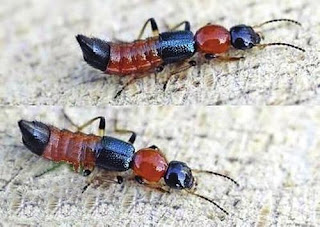The Acid bug ordeal...
Scientist call it Paederinae some call it Nairobi fly others call it rove beetle but i call it the Acid bug.
The acid bug is an insect that has a red and black body part and contains a corrosive substance called pederin that causes blistering or a burning sensation on a victim's skin.
I'm not a doctor or a dermatologist but i happen to encounter with this nightmare causing bug, after what it did to a pal of mine i had to consult a professional, here's what i learnt...
They are species of the rove beetle genus paederus that mostly live on rainy conditions.Outbreaks have occurred in 1998 and 2007. The bugs neither sting nor bite, but their haemolymph contains pederin a potent toxin that causes blistering.The toxin is released when the beetle is crushed against the skin, often at night, when sleepers inadvertently brush the insect from their faces. People are advised to gently brush or blow the insect off their skin to prevent irritation. The professional went on and told me that the insect is very small, making it hard to take precautions against, he added that people should go to the physician immediately if their skin is exposed to the pederin, and avoid applying medicine on their own because it sometimes causes infections or leaves scars, rather than healing the wound.
He told me the best way for treatment is with a treatment regimen that combined topical steroids with oral antihistamines and antibiotics. The doctor hypothesized that antibiotics are helpful because of the possible contamination of skin by pederin-producing bacteria.
thanks to Dr. Chris with his expertise.
The acid bug is an insect that has a red and black body part and contains a corrosive substance called pederin that causes blistering or a burning sensation on a victim's skin.
I'm not a doctor or a dermatologist but i happen to encounter with this nightmare causing bug, after what it did to a pal of mine i had to consult a professional, here's what i learnt...
They are species of the rove beetle genus paederus that mostly live on rainy conditions.Outbreaks have occurred in 1998 and 2007. The bugs neither sting nor bite, but their haemolymph contains pederin a potent toxin that causes blistering.The toxin is released when the beetle is crushed against the skin, often at night, when sleepers inadvertently brush the insect from their faces. People are advised to gently brush or blow the insect off their skin to prevent irritation. The professional went on and told me that the insect is very small, making it hard to take precautions against, he added that people should go to the physician immediately if their skin is exposed to the pederin, and avoid applying medicine on their own because it sometimes causes infections or leaves scars, rather than healing the wound.
He told me the best way for treatment is with a treatment regimen that combined topical steroids with oral antihistamines and antibiotics. The doctor hypothesized that antibiotics are helpful because of the possible contamination of skin by pederin-producing bacteria.
thanks to Dr. Chris with his expertise.


Comments